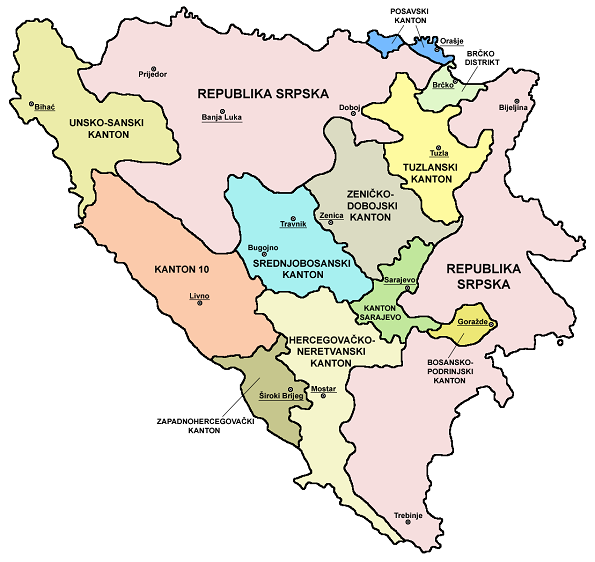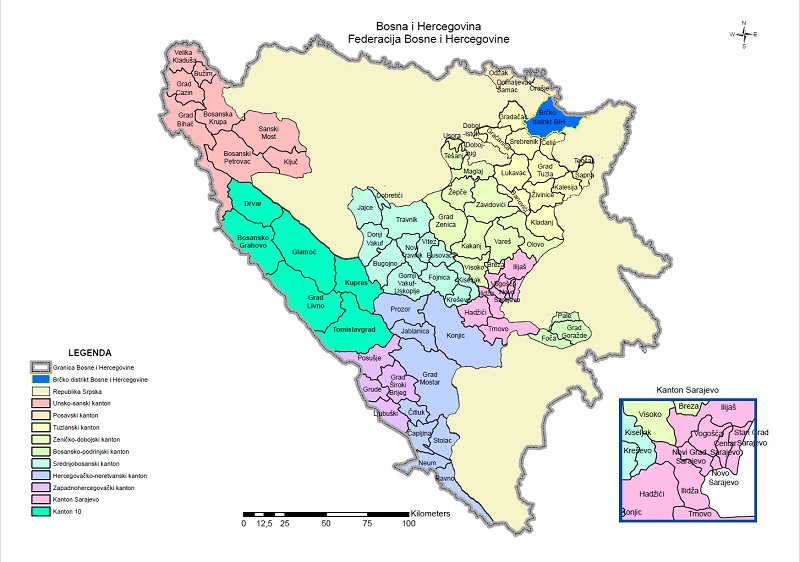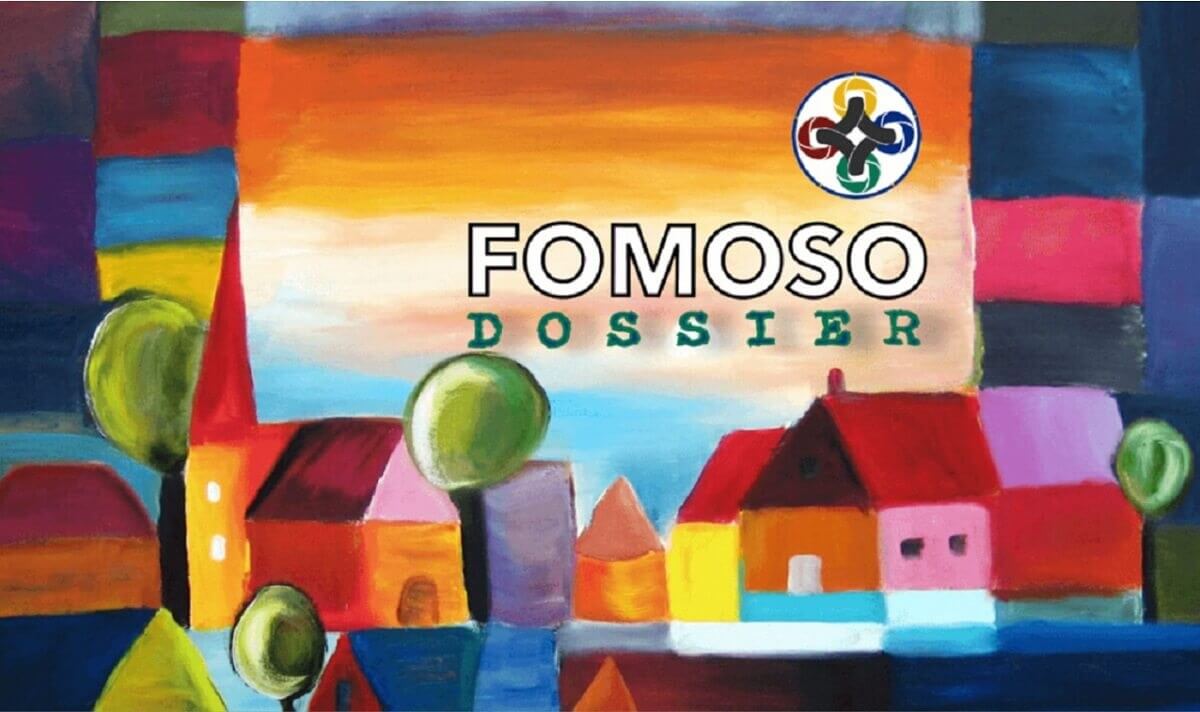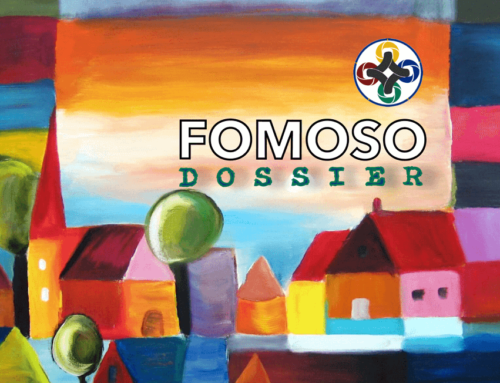Nadina Hodžić
Yugoslavia existed in several forms from 1918 – 1992 with a four-year interruption during the Second World War. From 1945 onwards, it consisted of six republics (Bosnia and Herzegovina, Croatia, Macedonia, Montenegro, Serbia, and Slovenia) and two autonomous provinces (Kosovo and Vojvodina). This decentralised structure was set in place to ensure representation of each republic within the League of Communists of Yugoslavia and grant them a certain degree of autonomy. However, it failed to keep this multi-ethnic state together for long.
The existence of the country rested on the idea of pan-Slavism and Yugoslavdom. After the Second World War, the vision of common national identity and shared loyalty to the state was actively endorsed with Yugoslav identity being introduced into 1961 census. Urbanisation, ethnic heterogeneity, increased political participation, and interethnic marriages have all contributed to envisioned nation-building. However, the decentralised structure of the state and growing dissatisfaction with politico-economic circumstances resulted in failure to establish shared identity. It also provided a fertile ground for emerging national leaders to advocate for the interests of their own ethnic communities.
There are several reasons that contributed to dissolution of Yugoslavia. Uneven economic development is often cited as the biggest factor, leading the representatives of Yugoslav Republics in LCY to start prioritising republic’s interests over federal ones. Additionally, Tito’s death in 1980 left Yugoslavia without the leader that had the ability to hold the country together and supress nationalism. As a result, nationalism started to grow, national parties were formed, and violent ethnic conflict emerged.
THe 1980’s were marked by Alija Izetbegović’s trial for hostile activity inspired by Muslim nationalism in his work Islamic Declaration and Franjo Tuđman’s national aspirations of Croatian autonomy and freedom. Slobodan Milošević rose to power in 1987 when he advocated for protection of Serbian minority in Kosovo. Although he effectively avoided the use of nationally tinted language in his political conduct, it became increasingly evident that perseverance of status quo would benefit the Serbian nation the most. Yugoslav republics did not find this idea appealing and have rejected attempts of re-establishment of Yugoslavia, deciding to secede. Early 1990’s witnessed the establishment of several Serb Autonomous Regions in Croatia and Bosnia and Herzegovina, with Serbian leadership wishing to preserve their nation in one country.
In 1991, both Croatia and Slovenia decided to separate from SFRY. The process was initiated on 25th June, with a ten-day War in Slovenia ensuing shortly after. The conflict was concluded by Brioni Accords, confirming Slovenia’s independent status and returning Yugoslav National Army to its base. It also marked the beginning of involvement of the European Community in the dissolution of Yugoslavia, after their initial refusal to back Slovenes and siding with Yugoslav leadership at the time which worked on strengthening of federal authority. Brioni Agreement temporarily suspended the process of Croatia’s independence; however, by late August full scale war in this country has already begun. One of the most important events in Croatian War for Independence, the Siege on Vukovar, was launched on 25th August and lasted for almost three months. The result was the Vukovar massacre, expulsion of Croat civilians from the city, and incorporation of the area into one of the Serbian Autonomous Oblasts formed the country. The unrests continued across the country and direct attacks by Yugoslav National Army intensified. In 1995, Croatia launched several offensives to retake lost territories. Operation Storm, one of the mentioned offensives, was heavily criticised by international community for committed atrocities, despite the fact that USA initially supported the plan.
In September 1991, it was Macedonia’s turn to declare independence. The country was officially recognised in 1992 and managed to peacefully secede from Yugoslavia. However, it is worth to note that after gaining its full independence and recognition, one year later it officially became a member of the UN under the name “Former Yugoslav Republic of Macedonia” due to the name dispute with Greece, which was just recently resolved. While contemporary North Macedonia did not fight against Yugoslavia for its independence, it did suffer an insurgency in 2001, where they clashed with Albanian minority in the country. In August the same year, the dispute was ended with Ohrid Agreement which resulted in Macedonian government ensuring greater rights for ethnic Albanians residing on Macedonian territory.
Another former Yugoslav republic to hold the referendum is Bosnia and Herzegovina. This state voted for independence in March 1992 and was officially recognised just one month later. These events also marked the beginning of Bosnian War, which will be the most destructive war in the series of Yugoslav wars. Croatia established their entity Herzeg-Bosnia in 1991 and the Serb parliament proclaimed Republika Srpska in March 1992, after leaving Bosnian parliament six months earlier. Sarajevo was besieged almost four years, marking the longest siege in modern military history. Along with Yugoslavia, Bosnia and Herzegovina also fought Croatia from 1992 to 1994. The Bosnian-Croat conflict ended in Washington Agreement that formally established the Federation of Bosnia and Herzegovina and the official ceasefire in the country was achieved by signing Dayton Peace Accords in 1995.

Montenegro peacefully separated from Serbia in 2006, avoiding the conflict. In a referendum with a 90% turnout, 56% voted for independence, dissolving the State Union of Serbia and Montenegro. In present day, former Yugoslav autonomous region of Vojvodina remains within Serbian borders and Kosovo continues existing as international protectorate and disputed territory. Kosovo has unilaterally declared independence in 2008, which Serbia refuses to acknowledge.
International involvement in the conflicts was severely limited at the beginning and more prominent in final years. Initially, the United States of America, as well as the European Union, have been rather indecisive and uninterested in the state of affairs in Yugoslavia region. The efforts were mainly of diplomatic nature. UNPROFOR was formed by UN Security Council Resolution 743 and deployed for peacekeeping purposes. There were numerous sanctions and resolutions imposed against Yugoslavia, including Resolution 757 banning all international trade, exchanges, and travel; and UN SCR 787 prohibiting shipments to and from Yugoslavia. Arms embargo was imposed in 1991, which disproportionately disadvantaged Bosnian side. In the duration of the wars, several peace plans were also drafted. Vance’s Plan for Croatia aimed for ceasefire in early 1992, but its implementation largely failed. For Bosnia and Herzegovina, those were: Carrington – Cutileiro plan (devolution of central government to three ethnic communities), Vance-Owen plan (10 ethnic provinces and multicultural Sarajevo district), Owen – Stolenberg plan (three ethnic mini-states, with Serbian side acquiring more than 50% of territory), and Contact Group plan (two entities and Sarajevo under UN). All plans were rejected by at least one warring side.
Nearing the end of the war, NATO became directly involved. First airstrikes in NATO history were conducted in 1994, in order to protect Goražde safe area. The strikes continued following the Markale massacres, including air campaign under the name Operation Deliberate Force. The missions of peacekeeping troops, primarily led by UNPROFOR, started intensifying as well. However, the missions failed to prevent genocide in Srebrenica, which was safe area protected by UN at that point. NATO continued to be directly involved in 1999, when airstrikes were conducted against Serbia after their dispute with ethnic Albanians in Kosovo. They have also established Implementation Force (IFOR) and Stabilisation Force (SFOR) following the end of Bosnian War, as well as peacebuilding Kosovo Force (KFOR). Concerning the legal matters, International Criminal Tribunal for the former Yugoslavia was established in 1991 to address violations of international law, including war crimes in the region. It formally ceased to exist in 2017.
In the outcome of the conflicts, more than 130,000 people were killed and economic damages were disastrous. It also identified the shortcomings of international intervention and general involvement of international community in disputes. Moreover, the independence status is still not resolved for some territories, considering the former autonomous region of Kosovo continues to search for solution to their question. Despite the post-war presence of transnational bodies, the situation in Western Balkans is still not harmonious. Post-conflict reconstruction, as well as conflict prevention and resolution, continue to be the focus of both international and regional authorities regarding contemporary political scene on the territory of former Yugoslavia. State-building, ensuring rule of law, democratisation, and promoting dialogue between political stakeholders were initial objectives of peacebuilding in the region. International actors are still notably involved, not only through transnational organisations and foreign investments, but also through special institution such as Office of High Representative in Bosnia and Herzegovina. Nongovernmental sector has been primarily involved in re-building of civil society, organising events for expansion of cultural ties, cultural and educational exchanges, and other seminars and conferences that aim to help warring sides deal with traumatic past. In the past few years, the emphasis has been on economic development, and particularly economic integration, with Mini-Schengen considered as a path towards reconciliation. Others, however, are wary of such idea and perceive the project as an attempt of creation of “new Yugoslavia”. The main objective of regional authorities remains to be accession to European Union and many believe Mini-Schengen will be able to prepare Western Balkan states for membership in this organisation. While the goals for the future are certainly ambitious, there are still numerous socio-political issues that require immediate attention. Despite notable political and economic commitment of all parties involved, almost 30 years after the collapse of Yugoslavia, full reconciliation between ex–Yugoslav nations is yet to take place.

Reference:
Petrović, I (2020) Mini Šengen: prednost zajedničkog nastupa. Deutsche Welle. [Accessed 22 February 2021] https://www.dw.com/sr/mini-%C5%A1engen-prednost-zajedni%C4%8Dkog-nastupa/a-55549611
Kivimaki et al. (2012) The Dynamics of Conflict in the Multi-ethnic State of Bosnia and Herzegovina. Friedrich-Ebert-Stiftung. [Accessed 22 February 2021] https://library.fes.de/pdf-files/bueros/sarajevo/09418.pdf
Sekulić et al. (1994) Who Were the Yugoslavs? Failed Sources of Common Identity in Former Yugoslavia, American Sociological Review, Vol. 59, No.1, 83-97
Booty, H (2012) Was nationalism the primary cause of the wars in the former Yugoslavia? E-International Relations. [Accessed 27 January 2021] https://www.e-ir.info/2011/02/28/was-nationalism-the-primary-cause-of-the-wars-in-the-former-yugoslavia/
Djilas, A (1993) A Profile of Slobodan Milošević, Foreign Affairs Vol. 72, No. 3, 81-96
Arikan, H (n.d.) The European Union Policy towards the Balkan States in the Post-Cold War Era, Journal of Social Sciences: Special Issue on Balkans, 15-22
Fazlagikj, A; Aliju, Dz (2020) N.Macedonia marks 29th anniversary of independence. Anadolu Agency. [Accessed 31 January 2021] https://www.aa.com.tr/en/europe/nmacedonia-marks-29th-anniversary-of-independence-/1966984
Human Rights Watch (1996) Impunity for Abuses Committed During „Operation Storm“ and the Denial of the Right of Refugees to Return to the Krajina. HRW. [Accessed 27 January 2021] https://www.hrw.org/reports/1996/Croatia.htm
de La Brosse, R (2003) Politička propaganda i projekt “Svi Srbi u jednoj državi”: posledice instrumentalizacije medija za ultranacionalističke svrhe. International Criminal Tribunal for the former Yugoslavia. [Accessed 25 January 2021] https://www.icty.org/x/cases/slobodan_milosevic/prosexp/bcs/rep-srb-b.htm
Vranić, I (2013) The International Community’s Peace Plans in Croatia and Bosnia and Herzegovina 1991-1995, Croatian Studies Review, Vol. 9, No. 1, 17-72
Bethlehem, D; Weller, M (1997) The Yugoslav Crisis in International Law, Cambridge University Press
Meisler, S. (1993), U.N. Refuses to Lift Bosnia Arms Embargo. Los Angeles Times. [Accessed on 25 January 2021] https://www.latimes.com/archives/la-xpm-1993-06-30-mn-8607-story.html
Traynor, I (2006) Montenegro vote finally seals death of Yugoslavia. The Guardian. [Accessed on 30 January 2021] https://www.theguardian.com/world/2006/may/22/balkans
NATO (2019) Peace support operations in Bosnia and Herzegovina. NATO. [Accessed on 31 January 2021] https://www.nato.int/cps/en/natolive/topics_52122.htm
NATO (2020) NATO’s role in Kosovo. NATO. https://www.nato.int/cps/en/natolive/topics_48818.htm
Sabljaković, Dž (2017) Kraj Haškog Tribunala. Deutsche Welle. [Accessed 31 January 2021] https://www.dw.com/bs/kraj-ha%C5%A1kog-tribunala/a-41544051


